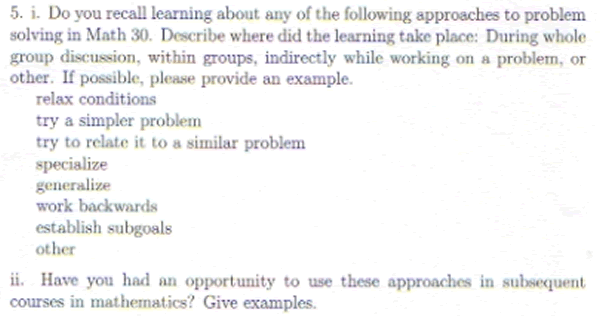

With the prompts students were far more apt to say they recognized particular heuristics and a majority of those interviewed said they recognized nearly all of these as coming up sometime or even often in the class or their own problems solvinig. The most common heuristics, those that "came up a lot" were "relax conditions" "try a simpler problem" and "try to relate to a similar problem." Most of the respondents seem to consider the first two the same. However, in only a few instances could they cite problems in which they made use of one of these approaches. Among the examples they did cite were the following:
Relax conditions arose in the problem of inscribing a square in a triangle, that is, to construct in an arbitrary triangle a square with two vertices on the base and one vertex each on the other two sides. This problem as an example of this heuristic is extensively discussed by Schoenfeld. One student cited problems concerning graphs, though gave no more specific information.
Perhaps the most common one recalled and for which examples were cited was the "try a simpler problem" heuristic. Most students identified this as their approach in combinatorial problems where they did investigations of particular cases and then looked for patterns, for example, a number of problems were assigned for which the answer was the Fibonacci sequence. Thus, working out some sequence of cases was viewed by the students as working on a simpler problem.
Some "examples" were also offered for the heuristic "try to relate to a similar problem." One student cited the Gaussian sum problem - find an expression for the sum of the first n integers and said they thought there were other problems that made use of the technique used to solve this problem. Another student thought that they had used this heuristic in solving recursion problems and problems in which Fibonacci had come up. A good example cited by a student was the relationship between two problems that each sought an infinite number of integral solutions to a single equation in three variable which was, indeed, one of the best examples of this in the entire class.
The only other heuristic about which anything concrete was offered was the idea of establishing subgoals. One student recalled doing this in solving a recursion problem. Another student mentioned this in connection with problems with an integer parameter which are attacked by doing an investiation and searching for a pattern.
Other than these no other specific examples were cited.
As for use in current classes, several students thought that they were being used but could again cite few examples. One student did suggest that in an independent study in number theory establishing subgoals was used in the proof that there are infinitely many primes with remainder 3 when divided by 4.